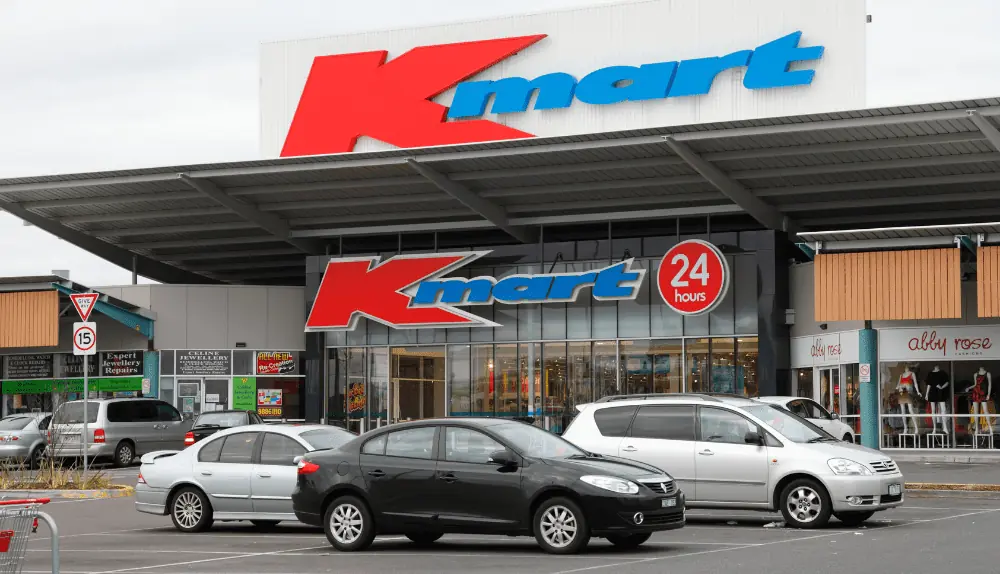Kmart was once one of the largest retail chains in the United States, with over 2,000 stores across the country. However, the discount retailer’s fortunes faded over the past couple of decades, as Walmart’s rise and shifting consumer habits took their toll.
Today, there are only three Kmart store locations left in operation, ghostly reminders of the era when Kmart was a ubiquitous presence in communities nationwide.
Though perhaps relics of a bygone time, these three remaining Kmarts have stalwartly endured where others have closed, clinging to their status as historic institutions and gathering places. For many shoppers and locals, a Kmart still stirs nostalgia for the days of their youth or early family life.
At their peak, Kmart stores were vibrant hubs where people would spend leisurely afternoons browsing racks, eating at the snack bar, and running into friends and neighbors.
While that experience is now largely consigned to history, the Kmart name and familiar big blue-roofed buildings continue to resonate in popular culture. Their remaining stores have secured a place in retail folklore, symbols of resilience, nostalgia, and an era now slipping into memory. By profiling these last Kmarts still operating, we can reflect on the chain’s rise and fall, as well as the impact it left on communities across America.
Though diminished, the Kmart story is a reminder of the outsized influence that retailers can have on culture, society, and place. Even with just a handful of stores remaining, Kmart’s legacy as a pioneering discounter will live on throughout history.
The Last Three Kmart Store locations
Of the three Kmarts left in operation, two are located in the Midwest and one on the East Coast. In Troy, Michigan, a Kmart has stood at the corner of South Telegraph Road and Big Beaver Road since 1972. It is the oldest remaining Kmart location, and according to employees, attracts shoppers from across metro Detroit clinging to memories of shopping there over the decades.

A few hours east in Muscatine, Iowa, another Kmart has served the local community since 1979. Muscatine residents speak nostalgically of shopping for school clothes or toys at the Kmart, which still maintains a loyal base of regular customers. Despite declining foot traffic in recent years, the Muscatine Kmart remains a gathering place where many locals can be found catching up, running into friends, or passing the time of day.
On the opposite side of the country, a third Kmart stands on Gallows Road in Virginia. Open since the early 1980s, the Gallows Road location has been an institution for Virginians looking for bargains on everything from clothes and kitchenware to electronics.
Like the last Kmart store locations, it carries with it the spirits of decades past, of families making cherished memories within its cavernous yellow walls and shopping for essentials at rock-bottom prices.
Each of these Kmarts tells its own unique story of the chain’s longevity and importance to place. They have defied the fate of closure that befell their countless counterparts, standing as monuments to history, community, and the era of the American discount retailer.
Their future remains uncertain, but for now, they survive on, ghosts of the past still clinging to life in the present day. Through these three stores, we can glimpse Kmart’s varied impact and the nostalgia surrounding it – even as the larger company itself faded from existence.
The closure of Kmart Store Locations
While the three remaining Kmart store locations represent a lingering reminder of the chain’s heyday, for decades Kmart shuttered hundreds of locations across the United States. By the late 2000s and 2010s, Kmart was closing underperforming stores at a rapid clip, unable to compete with the rise of Walmart and other retailers. As consumer habits shifted to shopping online and in discount stores alike, Kmart saw its sales and profits decline precipitously.

In response, Kmart launched a mass closure of stores, shuttering locations across the country at a rate of dozens or even hundreds per year. Once-bustling Kmarts were boarded up, left to decay as “dead malls” and symbols of the retail apocalypse. Empty lots stand where many former Kmarts once stood, a testament to the faded power of discount retail.
Communities lost gathering places and sources of employment, while customers found fewer options and sometimes had to travel greater distances to reach a remaining store. The closures struck a mournful chord, representing the diminishment of Kmart’s place in American culture and daily life. For those who grew up with Kmart, its shuttering felt like an end of an era.
While the closures were a difficult reality, they were likely inevitable given Kmart’s financial troubles and inability to keep pace with competitors. The rise of ecommerce, in particular, presented challenges that Kmart failed to meet successfully in its later years. However, the largely unremarkable way in which Kmart vanished from the retail landscape, through a slow process of decay rather than any major corporate drama, allows its history to be felt more acutely in hindsight.
Kmart’s mass closure still stands as an emblem of the precariousness of retail institutions and the way in which they can fade from existence almost without notice or fanfare, even after thriving for decades. Its story is a sobering reminder of the constant change in industries and communities, as well as a call to appreciate historic presences while they still stand.
The Legacy and Nostalgia of Kmart
While Kmart may have faded into obscurity, it continues to elicit nostalgia in those who grew up with it as a fixture of their communities. Kmart evokes memories of childhood, first jobs, and the evolving lives of families over generations. For many, it represents a more innocent and secure time, before the threat of chain closures and economic uncertainty loomed quite so large.
Kmart engenders nostalgia for blue-light specials, snack bars, portrait studios, and other elements of the total Kmart experience that made it a destination. Its retro design and logo seem plucked from another era, captivating those who remember when it was at the vanguard of discount retailing rather than a relic of the past. There is a wistfulness for the time before big box stores and e-commerce changed how Americans shopped forever.
Though few remain, the three operating Kmart store locations have become places of pilgrimage for those seeking to relive memories or capture a piece of history. People travel long distances to stand within their familiar yellow walls again, if only for a moment. The stores have developed almost a cult following, with enthusiasts documenting each remaining location and spreading news of their potential closure. For some, a world without Kmart is almost inconceivable, so deeply ingrained is it in their experience of life, work, and place.
While Kmart was ultimately unable to adapt to a changing industry, its impact on culture, community, and psychology cannot be overstated. It shaped retail in America for decades and brought affordability and convenience to millions of customers.
The nostalgia surrounding Kmart, even in death, serves as a testament to the memorable role it played for many during an important era of growth and change. Kmart may be gone, but it will live on through the aged snapshots, yellowed receipts, and well-worn memories of those who grew up with it as a constant presence.
Its story is one of American retail’s rise and fall, told through the lived experiences of customers rather than statistics or executive decisions. For this reason, Kmart’s legacy will endure long after the last store slides its metal gates closed for good.
Conclusion
Though only three Kmart store locations remain open across the country, these fading symbols of the past continue to represent the dynamic changes shaping retail and community. They have endured for decades through the force of habit, nostalgia, and the stubborn refusal to fade entirely into history. And yet, as the tides of time continue their relentless march, the day will inevitably come when the final Kmarts slip their doors closed for the last time.
When that day arrives, we will lose more than just buildings and prices – we will lose a piece of the American experience and the memories made within those cavernous yellow walls. Kmart was for many a gathering place and an anchor of routine, as familiar as it was affordable. Its disappearance leaves behind a wistfulness for the stability of the era in which it thrived, before the retail apocalypse and the fragile impermanence of institutions.
Though diminished, the Kmart story reminds us of the outsized influence that retailers can hold over culture and community. It serves as a sobering lesson in the pace of change and a call to appreciate the historic presence in our shared life, even as we embrace the new. When Kmart finally vanishes, its remaining locations will stand as monuments to the rise and fall of discount retail, as well as echoes of all the lives and memories made along the way.
We owe it to history to remember Kmart, not just as another chain swallowed into insignificance, but as a pioneering retailer that helped shape America. Its lasting impact may now be found more in nostalgia than business, but it represents an era of growth, access, and affordability that should not be forgotten.
Kmart’s story, from its humble beginnings to the handful of locations clinging to the past, teaches us more about the human experience than might be expected of a retailer. When the last of the Kmart store locations goes dark, its legend will continue.
This article has aimed to capture Kmart’s complex history, from its rise and fall to its lingering legacy, told through the stories of nostalgia, community, and change left in its wake. Though vastly diminished, the spirit of Kmart lives on in memories that transcend any single location. Its remaining monuments to the past remind us of the significance of an institution now fading into memory.

